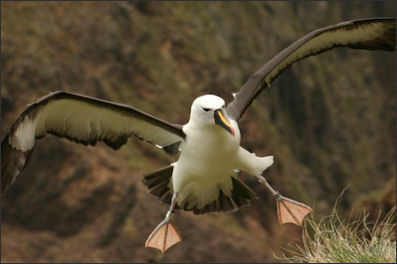ALBATROSSES
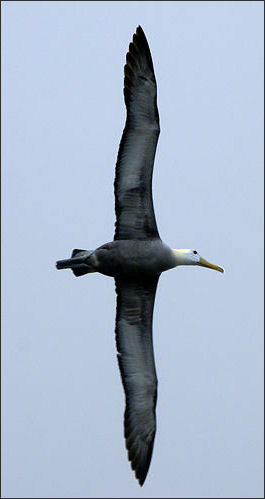
waved albatross
Albatrosses are very large sea birds with extraordinary capabilities. Carl Safina wrote in National Geographic, “An albatross is the grandest flying machine on Earth. An albatross is bone, feather, muscle, and the wind. An albatross is its own taunt longbow, the breeze its bowstring, propelling its body forward. An albatross is an art deco bird, striking of pattern, clean of line, epic in travels, heroically faithful. A parent albatross may fly more than 10,000 miles to deliver one meal to its chick...If you could travel millions of miles fueled by clean, self-renewing energy, you’d be an albatross.” [Source: Carl Safina, National Geographic, December 2007; Kennedy Warne, Smithsonian magazine, September 2007; Tui Dek Roy and Mark Jones, Natural History magazine, April 2009]
There are 21 species of albatross and they fall into three groups: 1) the great albatrosses (the wandering albatross, royal albatross and the nearly extinct Amsterdam albatross); 2) the mollymawks (with nine species); and 3) sooty albatrosses (two species). Mollymawks and sooty albatrosses are smaller than the great albatrosses. Mollymawk comes from a Dutch word meaning “foolish gull.” If all the species combined there are around 3 million albatrosses.
The wandering albatross has the largest wings of any bird: three to 4.5 meters across. Because such enormous wings are difficult to flap rapidly they have difficulty taking off. Some launch themselves off cliffs. Others leap into head winds which provide them with lift. Crowded colonies often have a landing strip where the birds can land and takeoff, with birds cuing up like waiting planes at an airport. Taking off is particularly hard for young birds.
Most albatrosses live in the Southern Hemisphere. There are large breeding colones in the Crozet Islands in the Indian Ocean, on South Georgia in the South Atlantic Ocean, and Campbell, Chatham and Snares islands in New Zealand. The largest colonies in the Northern Hemisphere are on a series of uninhabited island near Midway west of Hawaii, a few island near Japan, the Galapagos islands and some islands in the North Pacific.
Of the 21 albatross species, 19 are threatened or endangered. The Chatham albatross is critically endangered, with only about 11,000 of the birds remaining.
See Separate Articles: SEA BIRDS: TYPES, MIGRATIONS AND THREATS ioa.factsanddetails.com ; LARGE — WANDERING AND ROYAL —ALBATROSSES: CHARACTERISTICS, SUBSPECIES AND COURTSHIP ioa.factsanddetails.com
Websites and Resources: Animal Diversity Web (ADW) animaldiversity.org; National Oceanic and Atmospheric Administration (NOAA) noaa.gov; Encyclopedia of Life eol.org; Smithsonian Oceans Portal ocean.si.edu/ocean-life-ecosystems ; MarineBio marinebio.org/oceans/creatures; Expert: Paul Scofield, of New Zealand’s Canterbury Museum and co-author of “Albatrosses, Petrels and Shearwaters of the World”.
Albatrosses, History and Literature
 The word “albatross” comes from the Portuguese word “alcatraz”, also the source of the name of the famous San Francisco prison, which in turn was derived from the Arabic term “al-cadous”, or “bucket”-mouthed bird — a pelican. Albatrosses are related to petrels. The earliest fossils of recognizable albatrosses and petrels date back to 32 million years ago, and have been found in places as disparate as South Carolina and Germany. By 9 million years ago species very similar to modern albatrosses ranged over the Southern Ocean, North Pacific and North Atlantic.
The word “albatross” comes from the Portuguese word “alcatraz”, also the source of the name of the famous San Francisco prison, which in turn was derived from the Arabic term “al-cadous”, or “bucket”-mouthed bird — a pelican. Albatrosses are related to petrels. The earliest fossils of recognizable albatrosses and petrels date back to 32 million years ago, and have been found in places as disparate as South Carolina and Germany. By 9 million years ago species very similar to modern albatrosses ranged over the Southern Ocean, North Pacific and North Atlantic.
In “Moby Dick”, Herman Melville described the albatrosses “vast archangel wings.” The idea that albatrosses are good omens and that killing one is like killing the goose that laid the golden egg is expressed in the Samuel Taylor Coleridge poem “Rime of the Ancient Mariners”: “After shooting an albatross and suffering from poor winds and lack of water the mariner laments, “Ah! Well-a-day! What evil looks/ Had from old and young! / Instead of the cross, the Albatross/ About my neck was hung.”
Albatrosses have been following fishing vessels and whaling ships since before the time of Melville and Coleridge as loading up on fish offal dumped overboard was much easier the flying around trying to snag fish and squid that swam near the surface — the way albatrosses usually caught their food. Sometimes albatrosses followed ships for days in hopes of getting a handout.
In the early 20th century many albatrosses were killed were for their plumes. The soft, warm down and feathers of albatrosses were once greatly desired in the fashion industry.. Some species become nearly extinct due to the harvesting of the birds in the remote islands where they nest. Colonies near Japan and the Hawaiian Islands were nearly wiped out.
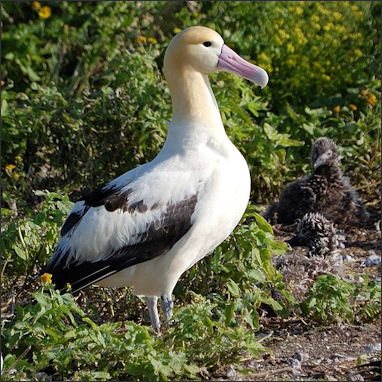
Short tailed albatross During the peak of these efforts crews of 300 men and women would kill all the birds the could get their hands on one island and then move on to the next one. Over 5 million short-tailed albatrosses alone were killed. Fowling as the practice was known was banned by the Japanese in 1906 but continued illegally. The Laysan albatrosses on Midway Island near Hawaii suffered when the island was paved for a U.S. navy base.
Albatross Characteristics
Albatrosses have large softball-size heads and 10-centimeter-long bills. Their primary food is squid. Many albatross have soft, down and feathers that keep them warm in frigid temperatures and howling wind. Like all birds air sacs in the lungs act like bellows, filling and then deflating, maximizing oxygen intake.
Otherwise albatrosses are built like gliders, The unfurled wings of a wandering albatross are locked into place by a tendon running between the shoulder and elbow joint. Muscles are powerful but they account for a lower percentage of their body weight than that of birds that rely on flapping. Internal struts reinforce light, hollow bones.
Albatrosses live to be 60 years old. They don’t begin breeding until they mature at around age 12 and lay only one egg when they breed every other year. They have special salt-excreting glands that allow them to drink saltwater and highly-developed olfactory senses for tracking down prey.
Albatrosses can not dive deep and swim underwater like penguins and some other sea birds. They pluck fish and squid that swim near the surface of the water. The prolonged “childhood,” the fact that albatrosses have only one chick and the long stretches of time the bird’s spend at sea are all adaptions to their limited hunting ability and patchy food supply.
Albatrosses in Flight
yellow nose albatross The largest albatrosses (royal albatrosses and wandering albatrosses) have a wingspan of up 3.65 meters (11.5 feet), the longest of any bird. The smallest albatross (the Indian yellow-nosed albatross) has a wingspan of two meters (6.5 feet), which is still longer than the wingspan of all but the largest NBA basketball players. Albatrosses have been known to fly 80,000 kilometers without touching land and glide for hundreds of kilometers without flapping their wings. A typical 50-year-old albatross is estimated to have flown at least 3.7 million miles.
The long narrow wings that are so cumbersome when taking off are ideal for soaring above the sea. Carl Safina wrote in National Geographic,’strictly speaking albatrosses are mediocre fliers — but excellent gliders. They can lock their wings in the open position like switchblades, the bird merely piloting the glider it inhabits. Catching the wind in their wings and sailing upward, harnessing gravity while planing seaward, they travel in long undulations. Most birds struggle to overcome wind; albatrosses exploit it.”
Albatrosses can glide about 20 feet forward for every foot they drop due to gravity but because they are incapable of sustaining flapping flight the need wind to fly and stay aloft. They turn into the wind to gain height, then glide back down for speed and distance. With each sweep it gains an altitude of about 20 meters when it climbs and speeds of 60kph when its speed up, taking advantage of winds slowed by friction near the ocean surface and those going at high speed about five meters up.
Describing the activity around a albatross colony Safina wrote, “Wind powers this mass-transit system. Many hurtle downwind; those going uphill weave into the air currents, catching the crosswind and sailing upward with their bellies windward, then turning downward into the breeze, masterfully playing these two great forces of wind and gravity, they make near-effortless progress.”
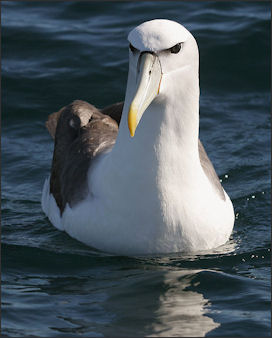
Shy mollymawk
But no matter how far they roam albatrosses always return to the islands of their birth to nest. On land, albatrosses seem out of their medium. They move with an awkward, spatulate-footed, head -wagging gait that cleanly shows their body was designed for flight and walk was an afterthought. The awkward gait of some species has earned them the name “gooney bird.”
Albatrosses at Sea
Albatrosses can spend months over the open sea without ever approaching land by using winds and air currents to stay aloft with a minimum of effort. Safina wrote in National Geographic, “Albatrosses comb the oceans for breakfast and are designed to touch shore only when it involves sex. Land is an inconvenient necessity for breeding...Graceful as angels and tight as leather, all albatrosses...spend months and sometimes years beyond sight of land, able to take the most hellacious punishment the ocean can hurl, While living in the windiest regions on Earth, they seem to inhabit another plane of existence.”
Some albatrosses soar on the easterly winds of the Antarctic and stay aloft of seven years, repeatedly circling the globe, dipping down only to feed on fish and squid, and finally landing on small windswept islands after they reach maturity and breed. For females, when their chick is old enough, they returns to the air.
Shy albatross annually migrate 10,000 kilometers between Australia and South Africa. The northern royal albatross can fly 1,800 kilometers in 24 hours and the grey-headed albatross can circle the globe in 42 days. All members of a group of grey-headed albatrosses studied by the British Antarctic Survey circled the globe, with three going around the world twice. All in an easterly direction, with one flying 22,000 kilometers in 46 days. Grey-headed albatross breed once every two years. Chicks leave the breeding area when they are 18 months old and wander the sea.

Black-browed albatross The yearlong journey of a grey-headed albatross was tracked by satellite with a transmitter. It more or less traveled east with the wind around the globe between 30 degrees and 60 degrees southern latitude between Antarctica and Argentina. South Africa and Australia, with extensive foraging trips around the remote South Georgia and Price Edward Islands. Foraging trips of wandering albatrosses, recorded with transmitters are hundreds even thousands of kilometers long.
Some species circumnavigate the globe, traveling 800 kilometers a day at speeds of 80 kilometers per hour. Because albatrosses can maintain their course day and night, cloudy weather and clear weather it is believed they have some kind of magnetic reckoning system, which allows them to fix their positions relative the earth’s magnetic fields. Albatrosses also seem to be able to predict the weather. Southern Buller’s albatrosses have been observed flying northwest when a west-winding-producing low pressure was imminent and flying northeast when an east-wind-producing high pressure was taking hold. The birds typically chose their direction 24 hours prior to the arrival of the system, suggesting they can respond to barometric cues.
Courting and Nesting Albatrosses
Albatrosses mate for life. Courting is something that takes place over a long time and is not taken lightly. Potential mates can spend much of their youth and adolescence getting to know each other and spend two years courting. The female not only has to secure a good provider (to bring back food from the sea) but also find a reliable partner who she can count on to come back while she sits for months with the eggs.
At the breeding areas couples spend long periods together, tenderly preening each other’s heads and necks. Some couples nibble at each other’s necks and stroke beaks.
Male albatrosses do a mating dance with their beaks up and wings outstretched to woo females. Other males may cut in and try to attract the female with their dance. She picks her favorite and joins the display by bowing and flapping in reply. Courting pairs bow, gaze and rise on their tip toes, beak to beak. Sometimes they work on nest construction for several seasons before they actually breed. Waved albatrosses of the Galapagos perform elaborate sequences of gaping, bowing, bill-fencing and sky-pointing, accompanying this with loud screams, moans and sighs.
Most albatrosses lay a single egg during the breeding season. Any more than that requires to much energy and attention. Albatross eggs take longer than the eggs of any other bird to reach the hatching stage (sometimes more 85 days longer than any other bird species). Some species lay eggs every two years.
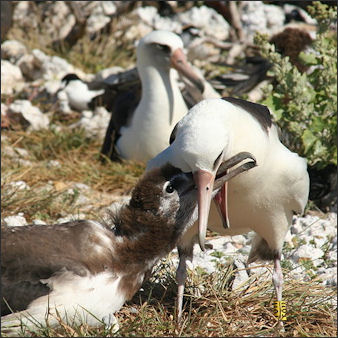
Laysan albatross feeding chick Pairs take turns keeping the single egg warm while their partner forages at sea for food, sometimes for weeks, covering hundreds or even thousand of kilometers. If an egg is left alone it quickly gets cold and the embryo dies. If food is o short supply or there is some other problem the chick is often sacrificed so the adults can survive. From an evolutionary point of view this makes sense because it can take four or five chicks to produce one adult. If even one parent doesn’t come back to the nest the chick will starve.
Royal albatrosses require a year to raise their young, an effort that leaves them exhausted. They need two years to regain their strength to breed again. Black-browed albatrosses build mud-pillar nests that resemble small elephant’s feet. About 399,000 pairs, two thirds of the world’s total of black-brows, breed in the Falkland Islands. Chatham albatrosses also build stump-like nests from dirt, rocks, wood chips, feathers and guano. Chicks spend four or five months sitting in the nests while their parents fly great distances in search of food.
Albatrosses Young
Albatrosses feed their young a thick concentrated oil that they extract from their prey and regurgitate in the mouths of their young. Describing feeding time at a nesting site in New Zealand, Safina wrote: “When parents arrived...the chicks excitedly position their bills crosswise, where the adult squirts a stream of oil as if filling a tank. An adult may spend 5 minutes ashore feeding its youngsters meal that’s a third of the chick’s body weight, then leave again for another trek of several weeks and thousands of miles. Between meals the chick converts oil into bone, flesh, and feathers. The chick grows so much between visits that adults recognize them not by sight, but by voice and scent.”
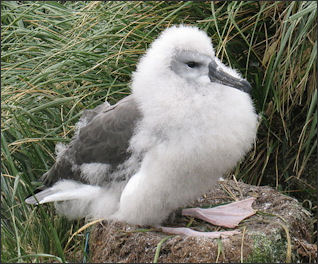
Grey-headed albatross chick Laysan albatrosses nest on Midway atoll west of Hawaii. Females lay their eggs and hatch their young in the winter. For the first six months of their lives the chicks are entirely dependent on their preants for nourishment, mostly in the form of half-digested squid and flying-fish eggs foraged at sea and regurgitated by their parents. Chicks are 18 inches tall when they are five months old and completely feathered except for their heads.
Grey-headed and Campbell albatrosses nest together on islands south of New Zealand. Parents watch over the young for the first three of four weeks of life. After that time they are left alone, strong enough to fend off attack from skuas and other predatory birds.
Some scientists and conservationists step in and help nesting birds, providing food to chicks whose parents had not returned with food and taking away eggs from clumsy first-time breeders who often break the eggs with their big webbed feet. The first-timers are given an infertile egg while the fertile egg is put in an incubator until it hatches. Breeding success is these places is 72 percent, compared to an estimated 33 percent had humans not assisted.
Fledglings of most species weigh nine kilograms or more — up to 50 percent more than adults. They need the extra fat to tide them over until they learn to feed themselves. The biologist Scott Shaffer told National Geographic, “Young birds have to learn to forage and navigate all on their own, and many of them die before they master the skills they needs on the open sea.”
Albatross Has a Chick at Age 71
Wisdom, a Laysan albatross who turned 71 in 2022, is the world's oldest known breeding bird. Residing at Midway Atoll National Wildlife Refuge, northwest of Hawaii, she became a mother in 2021 and 2022. U.S. Fish and Wildlife Service officials say Wisdom has raised at least 31 chicks. [Source: Zoë Miller,Azmi Haroun, Business Insider, December 25, 2022]
Business Insider reported: Believed to be at least 71 years old, Wisdom has far surpassed her species' typical lifespan of 12-40 years. She has made the news several times for continuing to lay eggs well into her old age. Wisdom returns annually to a nest site at Midway Atoll in the North Pacific Ocean.

black footed albatross “Laysan albatrosses usually only live for 12-40 years. But Wisdom was first identified by researchers in 1956. The father is Wisdom's partner, Akeakamai, who she has been with since 2012, US wildlife officials said. Albatrosses usually mate for life, but it is believed Wisdom had other partners in the past that she outlived.
“Wisdom laid her egg sometime during the last few days of November," the USFWS wrote in its statement announcing the new arrival. “Soon after, Wisdom returned to sea to forage and her mate Akeakamai took over incubation duties. Albatross parents share incubation duties and once the chick hatches, share feeding duties." The USFWS believes she has had at least 30 to 36 chicks in her lifetime. Albatrosses only hatch one egg every few years. The Midway Atoll wildlife refuge is home to the largest colony of albatross in the world.
Albatrosses Adolescents
Albatross young take a long time to grow up. They need the time to develop strong enough wings to keep them aloft for years. The most critical period is when they leave their nesting sites for the first time. Flying for the first time is a difficult task, one that isn’t helped by sharks waiting to gobble them in some place. Finding food for the first time on their own out at sea is no easy task either. Studies in the Indian Ocean suggest that 40 percent of young albatrosses fail to survive the first two nights after they fledge.
Adolescent Buller’s albatrosses form mixed-sex social groups called gams when they are two years old. When they are three, males make a nest site and female begin checking out the nest and “taking notes.” Pairs form the forth year that will more or less last for life. Only four percent of Buller’s albatrosses choose new partners. The first breeding attempts takes place the fifth year. Females have to be sufficiently fat and well nourish to trigger the desire to return to the breeding area, The supply of food locally determines whether an egg is produced.
Young southern royal albatrosses socialize in groups like human children and teenagers. Describing adolescents in a colony on the Falklands, Safina wrote in the National Geographic, “Like Kabuki dancers, they show off exaggerated movements, turning preening into choreography, fanning tails, cooing mutually extending their necks and laying bills together. They accentuate flawless wings, healthy plumage, and attentive grooming the way young teenagers accentuate skin and vigor, displaying precisely those body parts that indicate fertility.”
Tiger Sharks and Albatrosses
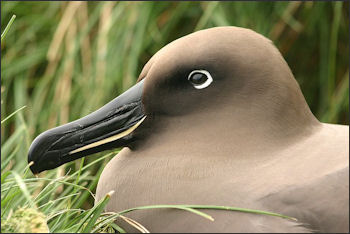
manteled albatross Tiger sharks are known to gather around some island where albatrosses are learning to fly. Young birds that struggle get aloft and approach to close to the water are snatched by the sharks. Describing attacks on Laysan and black-ff\oot albatross fledglings at the French Frigate Shoals of the Hawaiian Islands, Bill Curtsinger wrote in National Geographic, “Big tiger sharks show up in at the peak of the fledgling season, looking to eat young albatrosses lingering in the shallows.”
“Oblivious to the danger, the 30 or 40 chicks knew only that their departure time was now...Some of the birds caught the wind, sailed out clumsily over the water, gained momentum and flew off...Others landed a mere 30 yards from shore, where the situation was wilder. A shark would swim over to the spot and a hapless chick would disappear in a microsecond.” In an hour “five of the 16 fledglings” Curtsinger observed “were attacked and killed. Another was attacked and escaped. As the day progressed, more wind meant more flights, And the stronger winds gave the birds and extra edge, lifting them far offshore beyond the danger zone. The victims would fly, splash down, and preen their wigs, unaware of the danger intil disaster struck.”
“The sharks were often not as efficient as one might expect. I saw them miss their prey by several feet on the first try, spiral around for another assault, and zoom in for the kill. Sometimes the chick would get away before the second attack...Even if a bird survived an initial attack because the shark missed its target, the young albatross would often stay in the water. Some chicks even faced their pursuer and feebly pecked at the shark in a vain effort to ward off the 14-foot predator. Then they disappeared dragged underwater, swallowed whole. A few feathers remained drifting in the water along with bits of flesh that sank slowly to the bottom, erasing all evidence of the recent drama.”
Threatened Albatrosses
Nineteen of the 21 albatross species are threatened, endangered or vulnerable. Two species — the Amsterdam and Chatham albatrosses — are critically endangered. In some places the number of albatrosses has declined by half in the last 20 years. Biologists regard them as the world’s most threatened family of birds.
See Albatrosses, History and Literature Above
The problem in many nesting sites today is not hunters but introduced animals such as cats and dogs and especially mice and rats, Chicks are especially vulnerable because they are often left for long periods alone. On High Island, a British possession 2,700 kilometers west of Cape Town, South Africa, “monster mice” eat meter-high albatross chicks alive. The giant mice have grown exceptionally large by having such a large and easy-to-exploit food supply.
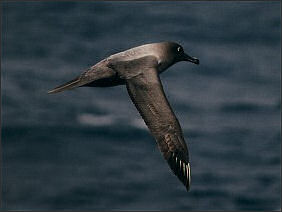
sooty albatross Albatrosses are a;so vulnerable to natural disasters. In 1985, a storm in the Chatham Islands in New Zealand sent huge waves and fierce winds over the island, killing many chicks and removing soil and vegetation pivotal to making nests. After the disaster the breeding success of nesting pairs dropped from 50 percent to 3 percent. The birds laid eggs on bare rocks that were broken doing incubations.
In Japan, albatrosses are being moved from Torishima, an island with a volcano that could erupt anytime that threatens the birds’ nesting sites, to an island 350 kilometers away that is safer. The move was deemed necessary as the number of birds has declined because so many albatrosses from the island were killed by long lines in Alaska.
In the albatrosses favor is the fact that many of their breeding areas are on remote, inhabited and rarely visited islands, and many of these islands are now protected areas.
One study found that 40 percent of albatross chicks on Midway Atoll die from starvation and dehydration related to eating plastic garbage. Examinations of their stomach reveal colored bottle caps, gold tees, combs, fishing lines, spray nozzles, toothbrushes, cigarettes lighters, toy soldiers, brushes, Lego bricks, clothes pins, fishing lures and syringes that their parents mistook for food and regurgitated in the chick’s mouths. This has occurred even though Midway is situated in the middle of the Pacific, far from any industrial zones or population center, and has only a few people living on it Some of albatross chicks suffer from deformities thought to be caused by lead paint.
Long Line and Trawler Fishing and Albatrosses
Albatrosses are perhaps threatened the most by long-line fishing fleets. By some estimates more than 100,000 albatrosses are killed each year — or about one every five minutes — when they dive for bait or fish caught in the lines and become hooked themselves. Unable to escape they drown and die. Albatrosses also like to trail behind trawlers that drag heavy trawl nets with cables that strike the bird’s long wings, killing them outright or injuring them badly enough they can’t fly.
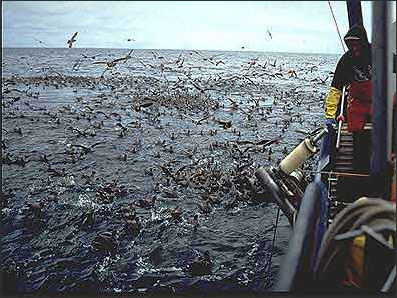
Seabirds and longliners Of 4,000 albatross autopsies by scientists in New Zealand nearly half had been killed by trawlers, The birds carried wounds — scrapped away skin and feathers and exposed bones — caused by the steel wires that pull the trawl nets. Large seabirds such as albatrosses tended to be injured as a result of collisions with the wires while smaller birds were caught in nets and crushed or drowned. The finding surprised conservationists that had thought that longlines were the main human threat to albatrosses.
Long line and trawl fleets from Argentina, Uruguay and Brazil had reduced the number of black-browed albatrosses to the point they were declared endangered in 2003. By some estimates a single boat can kill 140 birds a day. Many fishermen regard albatrosses as pests that eat their fish and don’t mind if they die. There have been reports of fishermen purposely catching albatrosses and eating them.
Many fishing vessel process their catch at sea, generating tons of discarded fish and fish parts that inevitably attract birds when they are dumped overboard. Few birds or sharks and other sea creatures can resist the temptation. To cut down on the amount of stuff thrown off the boats new vessels convert fish waste into fish meal. Boats that dump waste can reduce accidents and bird fatalities by not discharging the waste when long line or nets are set out.
Measures Taken by Long Line and Trawler Fishermen to Protect Albatrosses
Environmentalists are encouraging fishermen to plant red flags and curtains of fluttering streamers next to lines which scare away albatrosses and other sea birds. Other measures to protect seabirds include weighting lines with sinkers and setting lines from chutes or the sides of boats rather than the back so birds can’t get them, setting lines at night, using noise cannons to scare away birds, and using thawed baits, which sink faster than frozen ones. Some fishermen dye bait blue to make it harder for birds to see. By employing these low-cost methods New Zealand’s longline tuna fishermen reduced seabird deaths by 95 percent. Globally such measures are credited with saving an estimated 300,000 sea birds a year and reducing sea bird deaths by 85 percent.
More and more trawlers in sea bird areas are using a device called the Brady Bird Baffler, which uses weighted lines hanging from booms on each side of a boat’s stern to make a boat look larger from the back. The device keeps birds from away from the deadly trawl lines that run out of the back of the boat. The Carefree Cunning Contraption clips on to wires to make them look like hairy caterpillars from a distance. The Contraption makes wires more visible. If birds get too close the devices brushes their wings rather than injures them.

Buller's albatross The Albatross Task Force was set up in 2006 to get fishermen around the world to adopt these practices. The Australian ecologist Nigel Brothers who is credited with working out many of bird protection solutions, told National Geographic, “Fishing is hard, monotonous work, thousands of hooks baited, deployed and hauled per day. If fisherman have do something extra to save a bird or a turtle — if they don’t have an easy option that costs nothing — it won’t happen, You have to make conservation easy.” One fisherman who practices “seabird-smart fishing” told Smithsonian magazine, “I don’t like catching birds. I don’t like killing anything unnecessarily.”
But even if measures are widely adopted by regulated vessels there are large numbers of illegal, unregulated and unreported (IUU) vessels out there that skirt the rules and answer to no one. Some argue that the fishing industry actually does albatrosses a favor by providing them with food (the discarded fish), providing competitors with food (thus reducing competition for other food) and providing predators with food so they don’t feed on albatross chicks. Studies have show that 70 percent of the food brought by some albatross adults to their chicks comes from fishing vessels.
Studying Albatrosses
Sixteen albatross species are being tracked with satellite tracking devices. The size of popsicle sticks and outfit with GPS, the devices are placed between the shoulder blades and the bird is spray painted with a strip of blue so it can be easily recognized. Similar devices attached to their legs are outfit measure temperature, allowing scientists to tell whether the birds are flying, resting or feeding in the sea (the water is generally cooler than the air). The problem with some of the devices is that you have to get them back to retrieve the data from them, and they are most useful observing the movements of parents on weeks-long feeding forays from the breeding areas.
A study of albatross chicks on the U.S. Midway Islands found that 99 percent of those relocated to a new island more than 30 days after their birth returned to the their places of birth to breed rather than the new island but those relocated before they were 30 days old returned to the new island.
Scientist are enlisting the help of albatrosses, taking advantage of their travels in remote areas of the ocean, to help monitor the world’s climate. Scientist at the University of California, Santa Cruz are attaching small data loggers to albatrosses that will be able to measure sea surface temperatures across the North Pacific in greater detail than satellites. The data is expected to help fill in details missed by satellites.
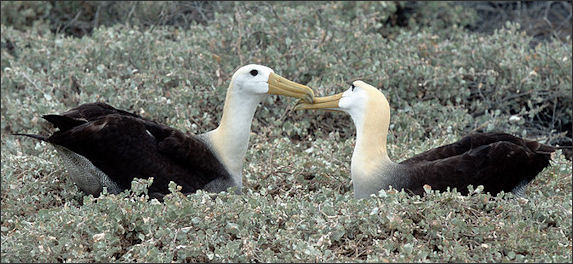
waved albatross
Scientists studying albatrosses have endured having their boats flipped over by storms, being marooned on remote islands for months and having to bolt their tents to rocks to prevent them from being blown away or washed away by an exceptionally large waves.
Image Sources: Wikimedia Commons, NOAA
Text Sources: Animal Diversity Web (ADW) animaldiversity.org; National Oceanic and Atmospheric Administration (NOAA) noaa.gov; Wikipedia, National Geographic, Live Science, BBC, Smithsonian, New York Times, Washington Post, Los Angeles Times, The New Yorker, Reuters, Associated Press, Lonely Planet Guides and various books and other publications.
Last Updated May 2023

